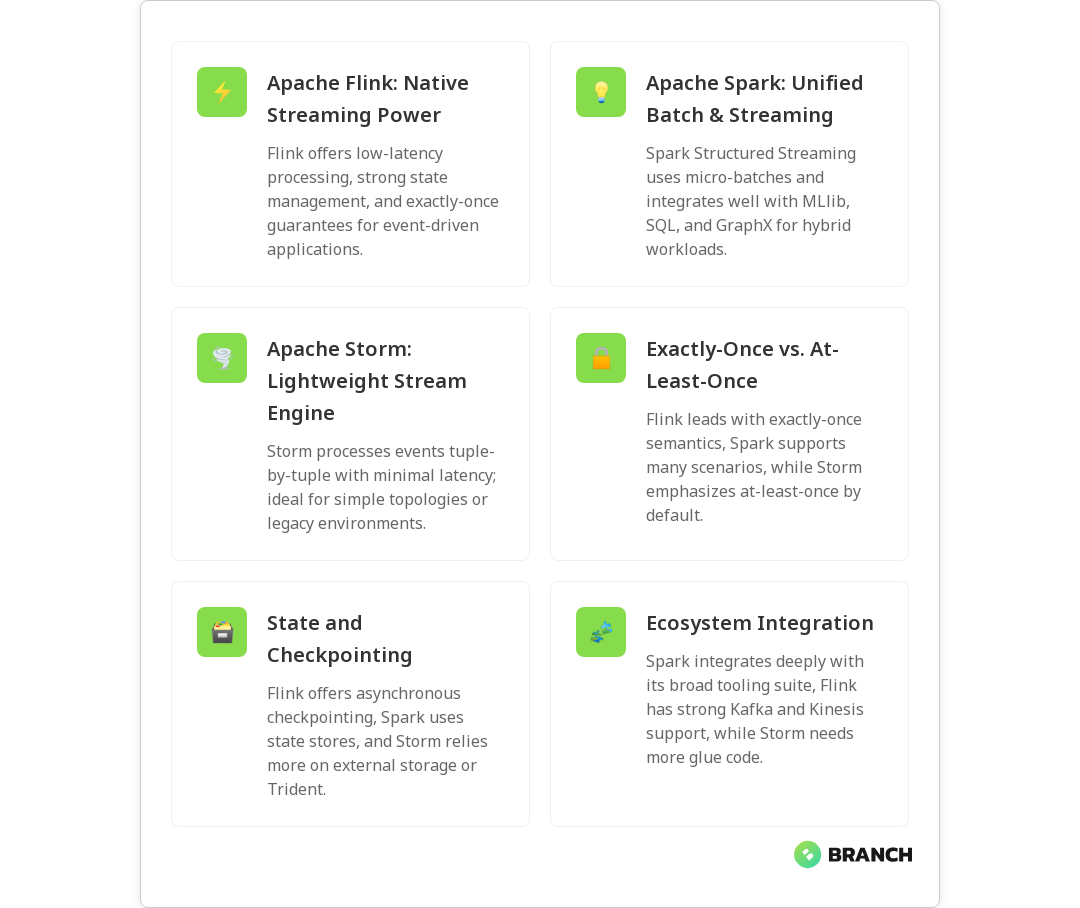Choosing the right engine for real-time data processing is like picking the right tool from a crowded toolbox — the wrong one makes the job slower, messier, or flat-out impossible. In this comparison we’ll look at Apache Spark, Apache Flink, and Apache Storm: how they process streams, where they shine, and what trade-offs you’ll make if you pick one over the others. You’ll learn about latency, state management, semantics (hello, exactly-once), operations, and real-world scenarios to help you decide which engine to use for your next streaming project.
Why real-time processing matters
Real-time processing turns a static, delayed view of events into an always-on, actionable stream of truth. From fraud detection and checkout personalization to telemetry monitoring and live dashboards, low-latency processing changes how businesses react to customers and systems. The right streaming platform enables teams to run analytics, update models, and trigger actions within milliseconds to seconds — which is a big competitive advantage when every millisecond counts.
Quick overview of the contenders
Apache Spark (Structured Streaming)
Spark started as a batch engine with powerful abstractions for distributed data processing. Structured Streaming brought streaming into Spark with a micro-batch model: the engine runs continuous micro-batches that approximate streaming while reusing Spark’s batch APIs. That design makes Spark a great choice when you want a unified batch-and-stream architecture and tight integration with Spark’s broad ecosystem (MLlib, GraphX, and Spark SQL). For a deeper breakdown of structured streaming and micro-batch behavior, see the concise redpanda guide.
Apache Flink
Flink was built from the ground up for streaming and offers a native stream processing engine. That gives it low-latency event processing, strong support for event-time semantics, and sophisticated state management with exactly-once guarantees. Flink also targets a unified batch/stream approach but treats streaming as the primary mode. If you need fine-grained event-time windows, watermarks, or long-lived keyed state, Flink tends to be the go-to option. AWS’s side-by-side comparison highlights how Flink’s asynchronous I/O and native streaming are used in production scenarios like Kinesis Data Analytics.
AWS comparison – A practical look at when Flink’s streaming-first model matters for throughput and latency.
Apache Storm
Storm is one of the earliest open-source stream processors focused on tuple-by-tuple processing. It’s a pure streaming engine with a lightweight model and historically has been used for low-latency real-time processing. While newer frameworks have absorbed much of its use cases, Storm still represents the archetype of pure streaming systems and can be a solid choice for simple, high-throughput topologies or teams with existing Storm expertise. For an architectural comparison between Storm and Flink, see the Storm vs Flink showdown.
Latency, throughput, and processing semantics
When evaluating streaming engines you’ll hear three terms a lot: latency (how long an event takes to be processed), throughput (how many events per second), and processing semantics (at-most-once, at-least-once, exactly-once). The choices you make depend on your constraints:
- Micro-batch (Spark Structured Streaming): predictable resource usage and easier integration with batch-oriented code, but higher minimum latency because events wait for the next micro-batch.
- Native streaming (Flink, Storm): lower per-event latency because events are processed as they arrive, often preferred for sub-second response requirements.
- Semantics: Flink offers strong exactly-once guarantees for stateful operations; Spark’s structured streaming supports end-to-end exactly-once semantics in many scenarios; Storm historically focused on at-least-once unless combined with Trident or external idempotent sinks.
For use cases where external systems are involved (databases, APIs), Flink’s support for asynchronous I/O and non-blocking external calls can yield higher end-to-end throughput, as discussed in the AWS comparison.
State management and fault tolerance
State is where streaming gets interesting — and challenging. Maintaining large, keyed state across many operators requires efficient storage, checkpointing, and recovery strategies.
- Flink: provides managed keyed state and asynchronous checkpointing to durable storage. Checkpoints and savepoints let you recover stateful jobs reliably and perform rolling upgrades or redeployments with minimal downtime.
- Spark: implements stateful streaming via state stores and checkpoints integrated with the Spark driver and executors; Structured Streaming is designed so you can resume from safe points using checkpoint directories and commonly accepted sinks that support idempotency.
- Storm: uses external storage or Trident semantics for strong state guarantees; however, operators tend to be more application-managed compared to Flink’s built-in state backends.
Operationally, checkpoint frequency, retention, and the choice of durable storage (S3, HDFS, cloud object stores) affect recovery time and cost. For production systems, automated testing of failure scenarios and restoring from checkpoints/savepoints should be part of your deployment checklist.
Integrations and ecosystem
Streaming rarely runs alone. You’ll almost always integrate with Kafka, Kinesis, databases, object stores, and orchestration systems. Consider how each engine plays with the ecosystem:
- Spark: excellent integration with the wider Spark ecosystem — streaming queries can leverage MLlib models, GraphX, and Spark SQL transforms with relative ease.
- Flink: tight connectors for Kafka, Kinesis (including Flink on Kinesis Data Analytics), and other sources; the runtime expects streaming-first thinking and provides robust connectors for stateful sinks.
- Storm: integrates well with messaging systems and can be embedded into lightweight topologies, but often requires more glue code for complex modern integrations.
When evaluating these platforms for a live system, consider managed offerings (cloud providers’ streaming services, Flink or Spark managed clusters) that reduce operational overhead. For practical examples of how Flink and Spark are used with cloud streaming services, review the AWS comparison linked earlier.
When to choose each engine — practical guidance
Your choice should be guided by requirements, team skills, and long-term maintenance cost. Here’s a short decision guide:
- Pick Flink when you need native streaming, event-time semantics, and advanced stateful processing (CEP, complex windows, long state retention).
- Pick Spark when you want one engine for both batch and streaming, need easy access to Spark’s ML and SQL ecosystem, and can tolerate micro-batch latencies (tens to hundreds of milliseconds or more).
- Pick Storm for lightweight, low-latency workloads or when you have existing Storm topologies and want minimal per-event overhead. Note that newer alternatives often meet Storm’s original use cases with richer features.
Real-world production choices often come down to operational familiarity: a team that already runs Spark at scale can often implement Structured Streaming more quickly than onboarding Flink — and vice versa. Benchmarks matter: run representative workloads to measure latency, throughput, and resource costs.
Challenges, trade-offs, and emerging trends
No engine is perfect. Common challenges include:
- Operational complexity: managing state, checkpoint storage, and versioned deployments.
- Cost vs. latency trade-offs: achieving lower latency usually means more compute and tighter resource management.
- Consistency across systems: integrating stateful stream processing with transactional sinks and databases remains a tough coordination problem.
Emerging trends are making streaming easier and more powerful. Unified stream-and-batch architectures, more managed cloud offerings, serverless or autoscaling streaming runtimes, and better developer ergonomics (stream SQL, improved SDKs) are moving the needle. The community comparisons and guides (including the redpanda guide and AWS side-by-side article) show the landscape evolving toward higher-level abstractions and operational simplicity.

FAQ
What is real-time data processing?
Real-time data processing ingests, processes, and acts on data almost immediately after it’s produced. “Real-time” can mean sub-second or a few seconds depending on context, but the key is minimal lag between event and actionable output.
Which tool is used for real-time data processing?
Common open-source tools include Apache Flink, Apache Spark (Structured Streaming), and Apache Storm. Each has trade-offs: Flink excels in native streaming and state handling, Spark integrates streaming with batch workloads, and Storm provides lightweight, low-latency tuple processing.
What are the two characteristics of real-time data processing?
Two defining traits are low latency (fast event-to-result turnaround) and continuous processing (persistent pipelines that handle ongoing streams). Other important factors include fault tolerance and stateful processing.
What is the difference between online and real-time data processing?
“Online” means systems are live and serving requests, while “real-time” emphasizes minimal latency in processing. Online systems can be real-time, but not all online systems are designed for low-latency data handling.
What are some examples of real-time processing?
Examples include fraud detection during payments, updating recommendations as users click, anomaly detection in telemetry, live dashboards, and real-time personalization of user experiences.




